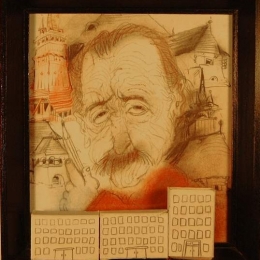art or business
Ferenc Sajdik's works
Ferenc Sajdik
graphic artist, caricaturist
born: Berlin, 21 August 1930
He spent his childhood in Athens after leaving Germany, in 1941 they moved back to Dunakeszi, into the paternal house.
1955-56: he was the contributor of Radio and Television Magazine from 1965: Ludas Matyi (Mat Goose - a caricature magazine) from 1993: Új Ludas (New Goose), Pesti Vicc (Pest Joke) and Úritök (Vegetable Marrow) - they are all caricature magazines.
He also makes book illustrations (Ágnes Bálint: Navigator's Log, the newest ones: Moravia's, Kipling's Tales) and cartoons as well (Pom Pom's Tales, The Great Fi-Fi-Fisherman).
His main works are: Sajdik-Gallery (1978), What Are Horses Like? (1981), What Are Cats Like?(1981), What Are Dogs Like?(1983), What Are Birds Like?(1984), Big Fax Book (1997).
Awards:
•1997: Munkácsy Mihály Prize
•1988: Artist of Merit.
FERENC SAJDIK'S WORKS
We only have conjectures concerning the 'parent' of the funny and heart-warmingly lovely figures though his book and press illustrations and cartoon figures (Pom Pom's Tales, The Great Fi-Fi-Fisherman, the Drawn Chicken commercial or his famous series: What Are Dogs Like?, What Are Birds Like?, etc.) can be seen at every turn.
Although the 'parent', Ferenc Sajdik's works are exhibited in several European galleries and museums, they are still occasionally seen in solo exhibitions in Hungary.
The characters of the exhibited works and their gestures might be familiar since they bear the marks of the Sajdik-features. Among his well known drawings (e.g. Homo Sapiens series, In Memoriam Agatha Christie) a portrait series (János Gálvölgyi, Elemér Hankiss, Imre Antal) complemented by new pieces, covering an entire wall, and his works not presented so far, actually, his paintings will be exhibited (e.g. Romeo and Juliet When They Were Just Children; When Carl Friedrich Drais First Galloped by His Gadget Through the Main Street of His Village Everybody Was Crying from Shame).
Caricature is one of the most flexible forms of art. It is capable of showing peculiar correlations. It expresses the funny, usually rather critical, thought-provoking, outspoken and truth seeker attitudes of sometimes festivals, the street and sometimes daily, weekly and monthly magazines. Ferenc Sajdik's exhibition starting on 4 April gives examples of the above mentioned.

